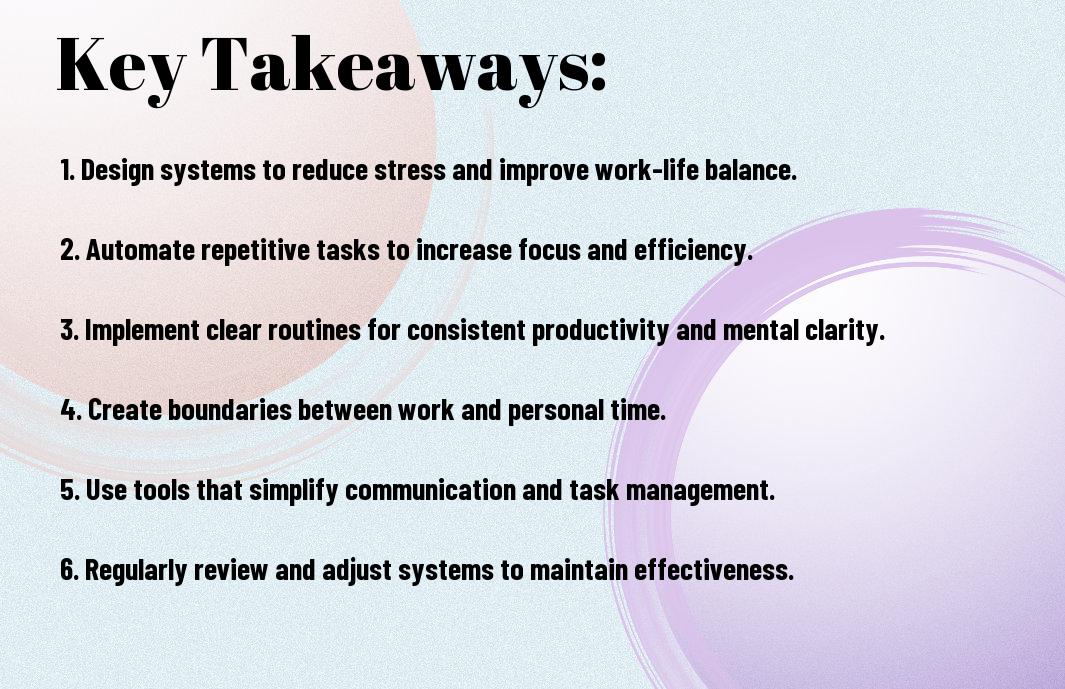There’s a pressing need for effective systems that maintain your mental well-being amidst the chaos of everyday life. In this blog post, you will discover how to implement strategies that foster productivity and reduce stress, allowing you to create an environment that not only enhances your work performance but also safeguards your sanity. By understanding the importance of tailored systems in your professional life, you can cultivate a workspace that promotes healthier work-life balance and supports your overall mental health.
Key Takeaways:
- Implementing effective systems can enhance productivity and mental well-being in the workplace.
- WorkWell emphasizes the importance of creating supportive environments that prioritize employee health and balance.
- Leaders should focus on continuous improvement and feedback to ensure systems evolve alongside workforce needs.

Rethinking Productivity: Beyond Traditional Metrics
Shifting the focus from conventional productivity metrics encourages a more holistic understanding of workplace effectiveness. Traditional measures often prioritize output speed and volume, leaving little room for recognizing how stress levels, creativity, and employee well-being contribute to success. Embracing a model that values quality over quantity can foster an environment where innovation and satisfaction thrive, ultimately benefiting both employees and organizations.
The Flaws of Conventional Success Measurement
Conventional success metrics, such as hours worked or projects completed, fail to account for employee well-being and the quality of work. These metrics encourage a culture of overwork that may lead to burnout and decreased motivation. They can create a false sense of accomplishment while neglecting the vital components of creativity, collaboration, and mental health. By relying solely on these outdated benchmarks, organizations overlook the real drivers of productivity.
Aligning Metrics with Mental Well-Being
Aligning productivity metrics with the mental well-being of employees fosters a healthier work environment. Integrating measures that account for employee satisfaction, work-life balance, and engagement levels can lead to improved overall performance. By focusing on holistic productivity, you encourage a culture where wellness and output go hand in hand, promoting a more sustainable approach to work.
This alignment involves implementing surveys to assess employee feelings about their workload, creating opportunities for feedback, and promoting breaks and flexible schedules. Establishing metrics such as team collaboration rates, creativity in problem-solving, and individual growth assessments can provide a clearer picture of productivity that prioritizes your well-being. For instance, companies that assess employee wellness alongside performance often see lower turnover rates and higher engagement scores. Cultivating a workplace where mental health is valued alongside performance metrics leads to a more resilient and effective workforce.
Designing Environments for Cognitive Comfort
Creating spaces that prioritize cognitive comfort is key to enhancing your productivity and overall well-being. Environment plays a significant role in how you function daily; thus, carefully designed spaces can lead to increased focus, reduced stress, and even improved creativity. For instance, incorporating elements that resonate with your values and goals can foster a more inviting atmosphere. Exploring options like HubSpot CMS vs Sanity: Find the Best Fit for Your Team allows you to align tools with your workspace needs, maximizing efficiency and satisfaction.
The Impact of Physical Spaces on Mental Health
Your physical workspace can substantially influence your mental health. Studies indicate that environments filled with natural light, colors that promote calm, and appropriate noise levels directly affect mood and productivity. Notably, workers in well-designed offices report stress reduction and improved satisfaction, resulting in a more efficient and engaged workforce.
Implementing Biophilic Elements in Workspaces
Integrating biophilic design elements into your workspace can significantly enhance your cognitive comfort. Incorporating aspects such as plants, natural materials, and daylight not only brightens your environment but also promotes a sense of connection with nature. Research shows that even small sources of greenery can lead to lower stress levels, better focus, and greater creativity. For example, one study found that the presence of plants in an office increased productivity by up to 15%. The benefits are clear: you can create a healthier, more uplifting space that mitigates the pressures of modern work life while optimizing your functionality and joy at work.

Integrative Approaches: Work-Life Balance as a System
Achieving true work-life balance necessitates viewing your life as an interconnected system rather than isolated parts. Recognizing how your job impacts your personal life—and vice versa—allows you to create an integrated approach to managing stress and ensuring fulfillment. By adopting strategies that promote health in all areas, you can establish a foundation that enables sustainable productivity and overall wellbeing.
The Myths of Multitasking and Continuous Availability
Believing that multitasking enhances your efficiency is a common misconception. Research shows that only about 2.5% of the population can effectively multitask, while most individuals suffer from reduced productivity and increased stress when trying to juggle multiple tasks. Similarly, the notion of being continuously available creates unrealistic expectations, eroding your ability to focus deeply and recharge your mind.
Strategies for Establishing Healthy Boundaries
Establishing healthy boundaries is important for maintaining your work-life balance. This can involve setting specific hours for work and personal activities, creating a dedicated workspace, and clearly communicating your availability to colleagues and family. Tools like calendar management apps can help segment your time, while setting “do not disturb” periods on devices promotes uninterrupted focus on your personal life. Strategies like these empower you to reclaim your time and energy.
One effective way to establish healthy boundaries is by committing to a “digital detox” at certain times of day. For example, consider logging off work emails after 6 PM to ensure you’re not pulled into work conversations during personal time. This simple act can boost your mental clarity and help you rejuvenate. Additionally, using “business hours” notifications on your work email alerts informs colleagues when they can expect a response, hence reducing the pressure to be perpetually available. Keep in mind, your productivity thrives when you protect your personal time just as rigorously as your work commitments.
Tools and Technologies for Sanity Preservation
In your pursuit of maintaining mental clarity, various tools and technologies can offer significant assistance. Whether it’s through apps designed to enhance focus or platforms that streamline communication, these resources create an environment where your mind can thrive. Prioritizing digital solutions that suit your workflow allows you to cultivate a more balanced lifestyle, ensuring that each day is more manageable and less overwhelming.
The Role of Mindfulness Apps and Techniques
Mindfulness apps like Headspace and Calm provide tailored experiences that help ground you in the present moment. Utilizing guided meditations, breathing exercises, and even sleep aids, these apps empower you to incorporate mindfulness into your daily routine, significantly reducing stress and enhancing overall well-being. Evidence shows that regular use can lower anxiety levels and improve focus, making them invaluable in your toolkit.
Automating Routine Tasks to Reduce Mental Load
Leveraging automation tools can significantly lighten your cognitive load, allowing you to focus on higher-priority tasks. Applications like Zapier or IFTTT automate repetitive tasks across your apps, while calendar tools such as Google Calendar send reminders for important deadlines. By minimizing mundane tasks, you free your mind to engage in more creative and fulfilling endeavors.
For instance, imagine setting up an automated workflow that organizes your emails into labeled folders based on project categories. This simple yet powerful solution not only saves you time but also provides clarity. Research indicates that businesses utilizing workflow automation report a 20% increase in productivity. By implementing these efficiencies, you reduce the clutter in your mind, promoting a clearer path toward your goals and enhancing your overall mental health.
Cultivating a Supportive Organizational Culture
A supportive organizational culture fosters an environment where your mental well-being is prioritized, enabling you to thrive at work. By promoting values such as empathy, collaboration, and transparency, your organization can create a space where everyone is encouraged to share their thoughts and concerns. Initiatives such as Working at Home: Ways to Protect Your Health and Sanity can significantly contribute to developing such a culture.
The Power of Open Communication and Feedback Loops
Open communication and feedback loops are crucial for creating a culture that supports sanity. Encouraging regular conversations allows you to express concerns and share ideas freely. Constructive feedback not only aids personal growth but also builds trust among team members. This transparency creates a safe space where you are more likely to approach your supervisors and colleagues with issues before they escalate.
Developing Training Programs Focused on Mental Resilience
Training programs aimed at enhancing mental resilience equip you with crucial coping strategies to navigate workplace challenges. By integrating mindfulness practices, stress management workshops, and emotional intelligence training, you can strengthen your ability to resist burnout and adversity. These programs promote not just individual well-being but also team cohesion, creating a collective capacity to handle stress effectively.
Implementing training programs that focus on mental resilience can transform your workplace experience. Research shows that organizations investing in mental health training report lower absenteeism and higher job satisfaction. Workshops that teach conflict resolution, active listening, and stress-coping strategies foster an environment where you feel empowered. By building these skills, you not only enhance your capacity to handle daily pressures but also contribute to a more positive workplace culture where everyone thrives together.
Final Words
Presently, as you navigate the complexities of work and life, implementing systems that prioritize sanity is imperative for your well-being. WorkWell provides you with the tools and frameworks needed to create a balanced environment, ensuring you can thrive both professionally and personally. By adopting these practices, you empower yourself to maintain focus, manage stress, and cultivate a healthier mindset. Your journey towards a more sustainable work-life balance starts here—embracing systems that support your mental and emotional wellness can transform your experience and enhance your overall quality of life.
FAQ
Q: What is the primary goal of WorkWell?
A: The primary goal of WorkWell is to create systems and work environments that prioritize the mental well-being and overall health of employees. This involves developing strategies and tools that help build a supportive framework within organizations, ensuring that workers find balance between their professional responsibilities and personal lives. By focusing on mental health, WorkWell aims to foster a positive workplace culture that enhances productivity and engages employees meaningfully.
Q: How does WorkWell assess the mental health needs of employees?
A: WorkWell employs a multi-faceted approach to assess the mental health needs of employees, which includes anonymous surveys, regular check-ins, and feedback mechanisms to gather insights about workplace stressors. Furthermore, it analyzes workplace dynamics and employee interactions. By combining qualitative and quantitative data, WorkWell is able to tailor specific programs and interventions that address the unique needs and challenges faced by different teams and individuals within the organization.
Q: What kind of systems does WorkWell implement to support employee well-being?
A: WorkWell implements a variety of systems designed to support employee well-being, including flexible work arrangements, mental health training programs, peer support networks, and wellness resources. Additionally, it offers access to counseling services, wellness workshops, and tools for stress management. By creating an inclusive environment and providing practical solutions, WorkWell not only seeks to reduce stress and prevent burnout but also fosters resilience and encourages employees to take an active role in their mental health journey.

Leave a Reply